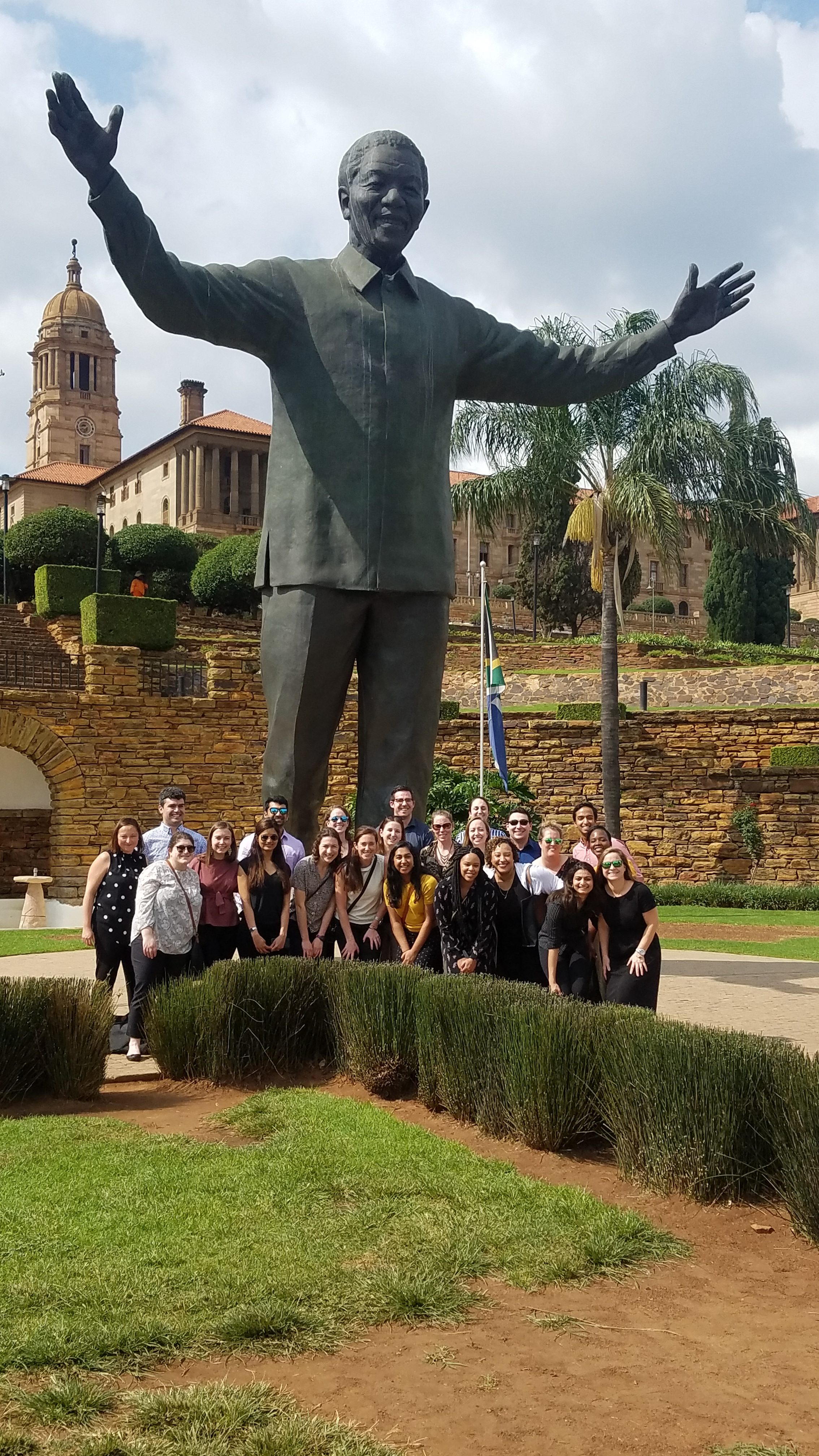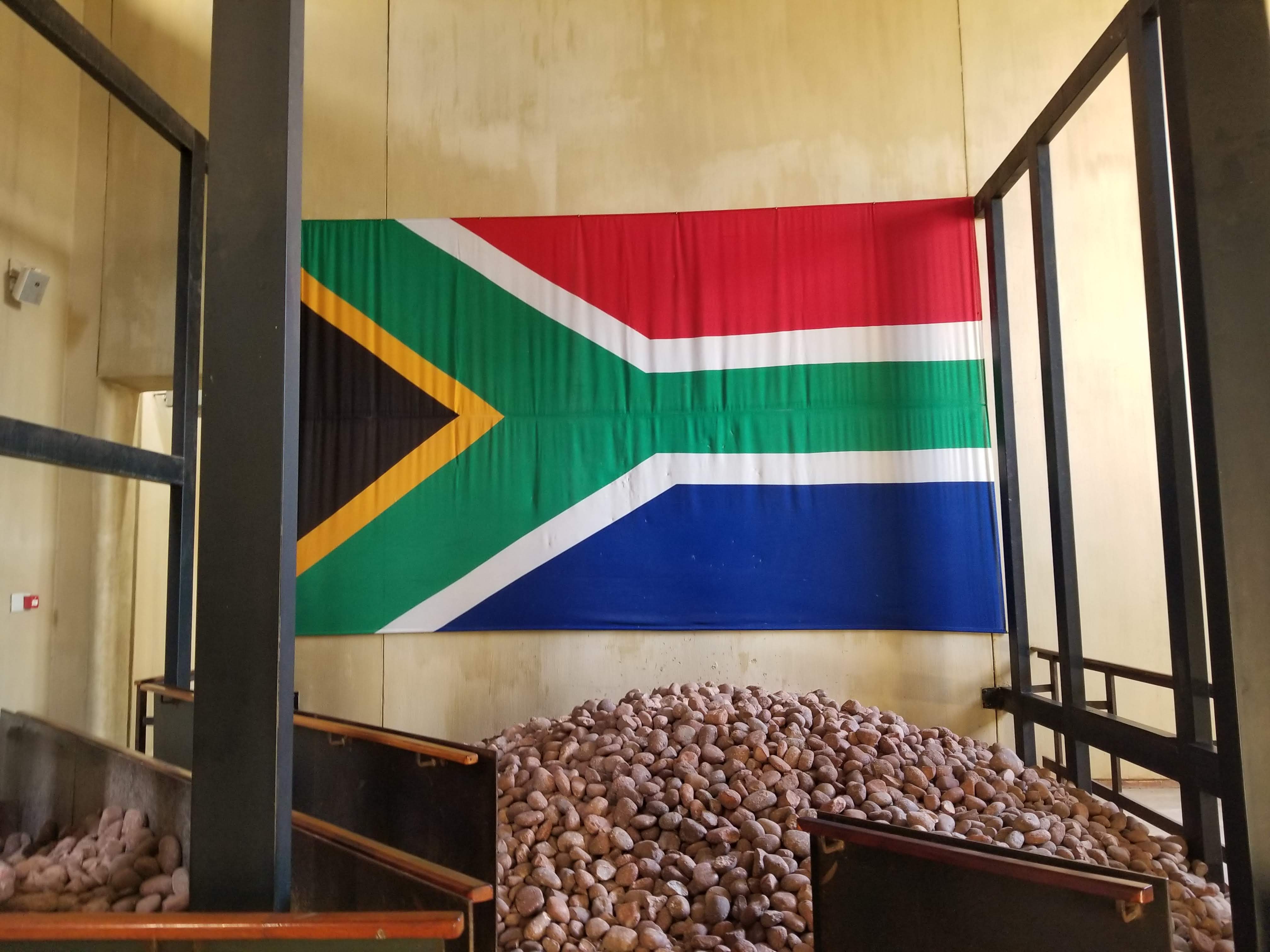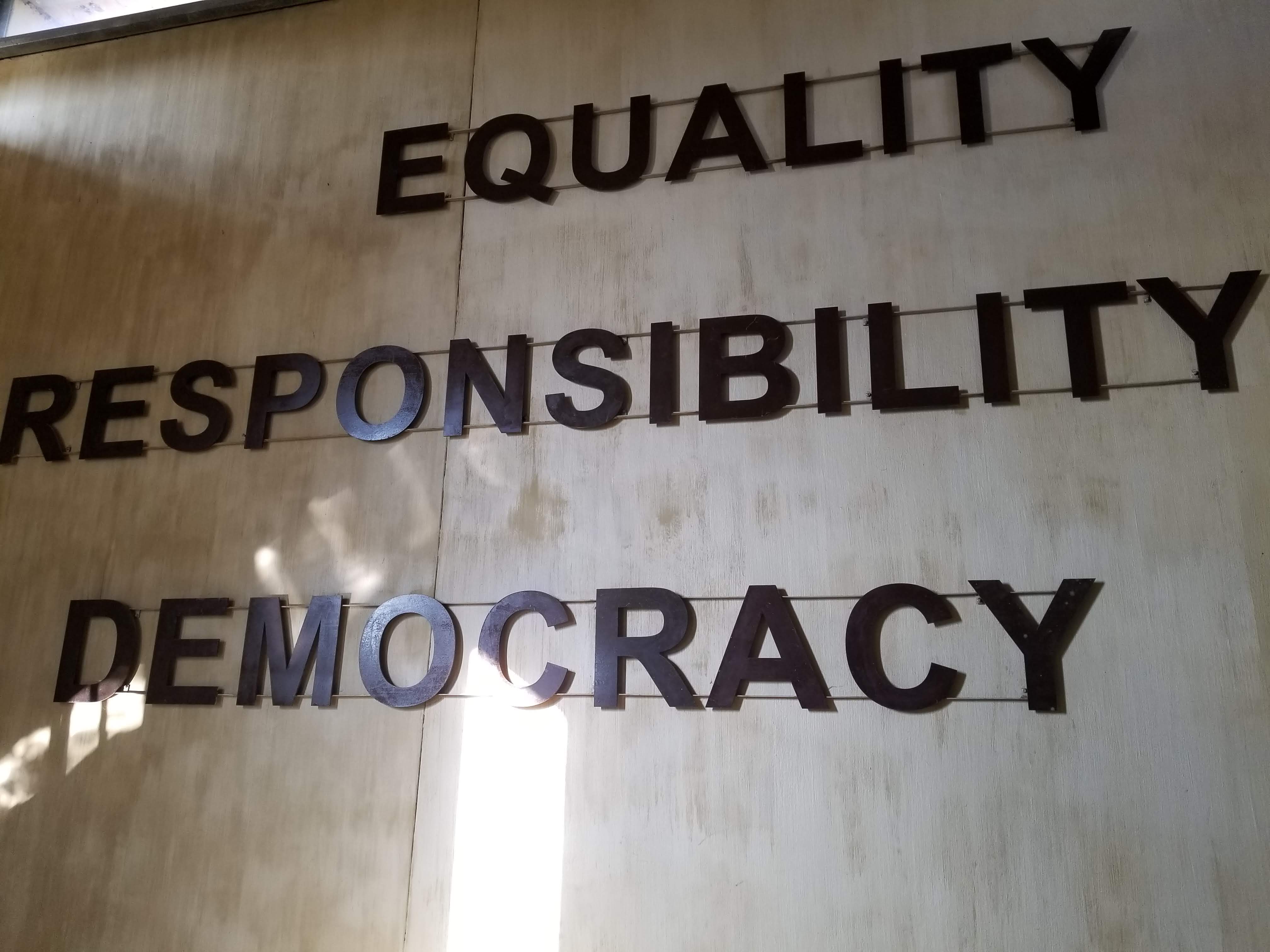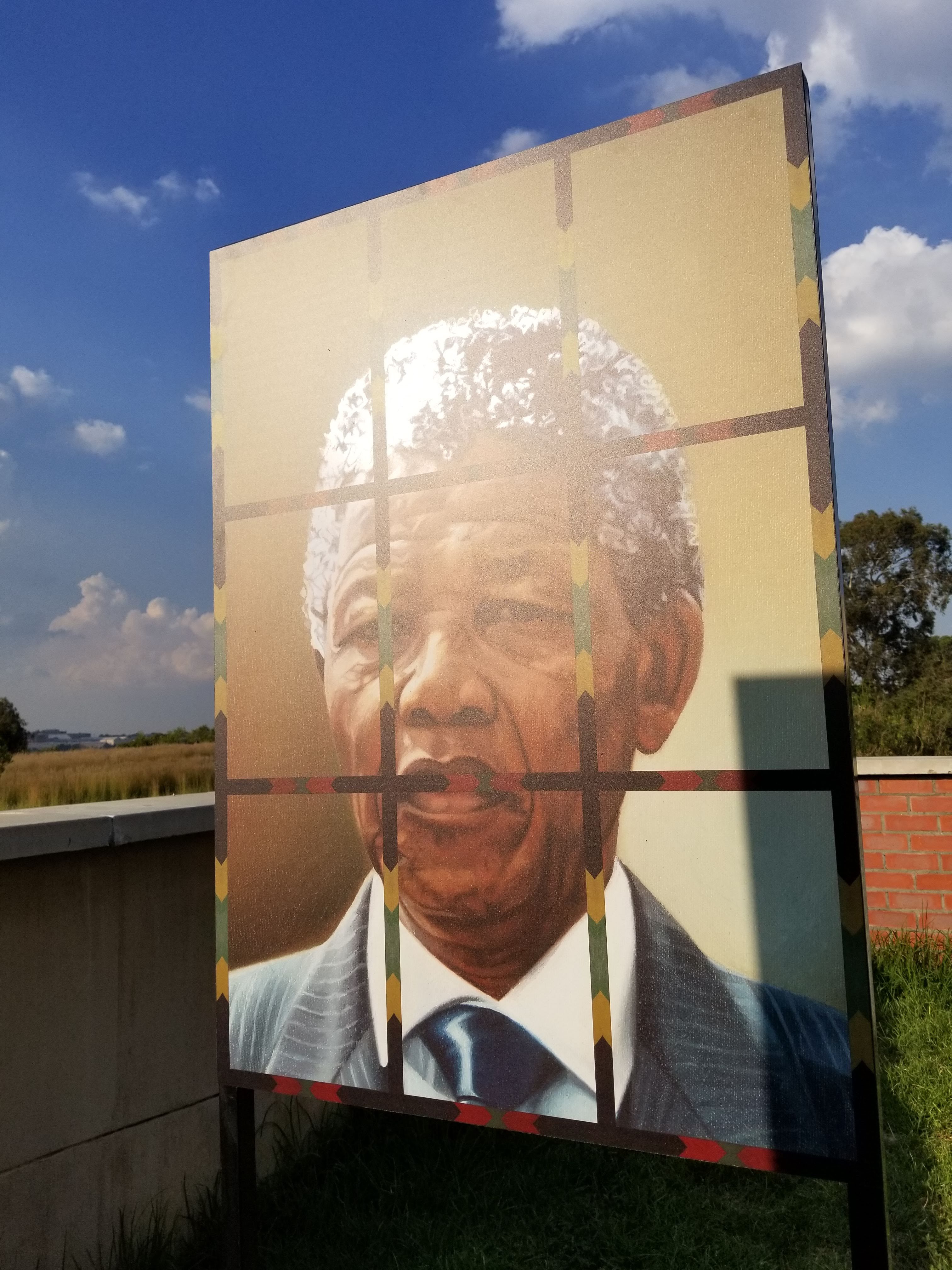South Africa (Spring 2019)
Student participants in the Social Impact Field Seminar 2019 South Africa share their reflections on their learning experience in the below blog posts (unedited)

The people of South Africa
By Aleena
If I had to pick one thing that really stood out to me in South Africa, it is definitely the people.
South Africa is breathtaking. The grass is very green, weather is quite agreeable and food is delicious. But that is not what makes me want to book another flight back to Johannesburg. It may be part of it, but that is not ‘it’. If I had to pick one thing that really stood out to me in South Africa, it is definitely the people.
South Africa has a dark, sad history. We had learnt about the cruelties of the Apartheid movement multiple times. But stepping foot in a museum dedicated to educating one about the extent of race entitlement and apartheid really drives the point home. Walking into cramped solitary confinement cells where trail blazers were locked 24 hours a day makes you realize the extreme physical and mental torture endured for the sake of basic human rights.
Another visit was to Hector Museum, dedicated to the 176 school children who lost their lives during a peaceful protest over, essentially, their school curriculum. This sounds like something out of a horror movie, and it truly should be, but sadly it all happened only 43 years ago. This makes one wonder how mankind can be so unfair to one another. It made me think about how we often watch movies of aliens invading our planet and mankind banding together to fight them off- looking at how poorly we treat each over the smallest of differences, it seems highly unlikely any ‘banding together’ will occur, if ever the need arises!
We were assured time and time again that any racial discrimination is long gone. ‘Racism is not to be tolerated’ was the phrase repeatedly narrated to us by our tour guide. However, passing through neighborhoods in Soweto, where electricity had to be stolen to power what was most likely a single fan to survive the growing heat; into neighborhoods in the suburbs of Johannesburg where behind gated houses one could catch glimpses of aesthetic waterfalls in backyards- most likely powered by electricity. Financial disparity was very stark. This does make one wonder that if the poor continue to live in areas like Soweto, without proper infrastructure, education, electricity and drinking water- then how are they ever to break out of Soweto? How can they ever afford an aesthetically pleasing waterfall house in that fancy Johannesburg suburb?
Yes, Afrikaans was removed from the curriculum and reforms were put in place to abolish all racial prohibitions- but is that enough? Or is more required to balance out the systematic injustice endured by a community which existed in harmony until colonized by people because they thought they could? In a capitalist country, there will always be some rich, and some poor, no doubt. However, when almost all decisions are being driven by the color of your skin, it seems a bit too frustratingly unfair.
We visited multiple organizations, all driven by the idea of social impact, and they are no doubt doing meaningful work. It is organizations like WHO, WITs and Nene Molefi, to name a few, that will be able to bridge the invisible, but very real gap that still exists.
Back to my earlier note about the wonderful people. Even after all the injustice and frustrating prejudices, the people were wonderful. Beyond hospitable. People who drive Ubers, serve at restaurants and give tours. Blue collar people. People who know how to find happiness in the little things in life. No one was really out to rob you, they were simply trying to make a decent living to take home. Should I pay 250 ZAR for this book-end or bring it down to 200? Do the extra 3 dollars really matter to me? Not really. But do they matter to the guy with his business set up on the side of a dirt road? Probably. Truth be told, it could pay for his electricity. And that is my biggest takeaway lesson.
The importance of cross-sector partnerships and value of diverse perspectives
By Patricia
Our company visits afforded us a look into a wide variety of social impact work, ranging from impact investing to public health, energy, education and diversity and inclusion.
Organizations like Sesha Capital, an investment firm founded by two young former consultants, closely resembled the kinds of budding companies we might come across in business school circles. Others, like Room to Read spoke to some of the challenges that don't always make it into class discussions. Room to Read is an international youth literacy organization with a South Africa chapter. (I've actually supported the organization and have been on their email list since college!) Through our discussion with the leaders of the Room to Read SA team, we gained insights into the programmatic challenges that come with running a local chapter of a national nonprofit, such as how to translate an established curriculum to a specific location - especially one like South Africa where reading programs need to consider the wide range of languages spoken by students.
A key theme of some of the other visits was the role of cross-sector partnerships in getting social impact projects off the ground.
I was particularly interested in the cross-sector work we learned about in the energy sector. While visiting Eaton Electric, we were treated to a presentation by Power Africa, a U.S. government-led partnership started under the Obama administration and coordinated by USAID. Power Africa's goal is to address the two out of three people in sub-Saharan Africa who lack access to electricity by adding 30,000 MW of cleaner generation capacity and 60 million new home and business connections. Power Africa functions as a hub for companies, financial institutions, and governments to coordinate the actions necessarily to identify potential partnerships, secure funding, and maintain on-the-ground support. In all, much of Power Africa's work seems to de-risk the transition to cleaner more efficient energy. Throughout our trip, we saw many promising signs of increased access to energy with rows of homes equipped with solar panels, but also evidence of the remaining challenges with load shedding and power outages. In all, the falling prices of pv solar generation and battery storage, proliferation of clean tech companies, and facilitation work from the likes of Power Africa point to tremendous opportunities for positive changes in the power sector.
My consulting project group had a chance to chat at some length with folks from Power Africa and Eaton Electric (including a BU alum!), all of whom emphasized the value of diverse perspectives in trying to solve problems at the scale of energy transformation in South Africa. They commented on our group’s wide range of backgrounds and how we could each bring valuable insights to this work, regardless of a non-technical background outside the industry.
These conversations gave me a renewed confidence in my ability to build on my experience in South Africa and continue working to address pressing social and environmental challenges.
Stark contrasts
By Julie
The social impact field seminar was a powerful and humbling experience that brought to light the unique challenges facing South Africa. One thought I kept coming back to throughout the week was that South Africa was one of stark contrasts. On one hand, I was in awe of the extraordinary natural beauty of the savannah and magnificent African wildlife I witnessed on the safari as well as the stunning beauty of Table Mountain and the vast vineyards in Cape Town. On the other hand, I was often reminded of South Africa’s dark and deeply troubling past persisting from the apartheid era and the lack of progress still faced by much of the country in the neighborhoods surrounding Johannesburg.
Our visit to Soweto was emotional and eye-opening, to say the least. As we drove through Soweto and other impoverished townships, I observed firsthand the terrible living conditions these poor communities endure and the darkness they frequently face during the daily scheduled power outages known as load shedding. These images contrasted sharply with our experience of staying in the newer, wealthy neighborhood of Sandton filled with shopping malls and nice restaurants. Although we were told that we should be careful of crime and more aware of our surroundings, it was hard to imagine not feeling safe with the high walls and electric fencing encompassing the majority of the buildings and establishments.
While we were heading to the safari in Pilanesberg, I was given time to reflect on what I learned and observed from the previous day in Soweto.
It was essential that while on this field seminar we also absorbed the immense pain and suffering that South Africans experienced as part of the systemic racial discrimination so that we could put into perspective just how powerful change can be.
In reading the narratives of people who lived through apartheid and seeing photographs and videos while at the Apartheid Museum of the horrific brutality inflicted upon the many activists, I felt disturbed and mortified that such oppression existed not that long ago. The image of Hector Peterson’s lifeless body being carried through the streets by his brother is not one I will soon forget.
It’s important to acknowledge the country’s past in order to come to terms with the changes that must occur. The businesses we visited are working to address challenges South African people face, such as access to education and healthcare, electricity, and social inclusion.
It was enlightening and impactful to hear the discussions of the context in which these challenges take place so that we can have a better appreciation for the growth and improvements taking place.
While there is much progress to be made, I was impressed with the work that is currently being done to create sustainable opportunities in these areas. I am hopeful that these organizations will to continue to make meaningful developments to support these underserved communities and bring equality to all of South Africa.
Learning from the past to build a better future
By Brian
[P]ost-apartheid is not a time period that has an end date
When I travel to a new country, I try to learn as much as I can about the history and culture of that place. This helps me to gain more context about why a place is a certain way and why people behave in a specific manner. One of the most moving visits during the week was our trip to the Apartheid Museum. The topic of apartheid is extremely important to discuss because the vestiges of apartheid can still be felt in South Africa. The businesses that we visited are focused on making a difference in areas such as education, healthcare, financial investments, and job creation – areas that many were denied access to under apartheid. Knowing this is extremely important to understanding the current business climate and the challenges that exist today in South Africa.

The exhibit that resonated the most with me was “Total Onslaught.” This exhibit included a 20 minute movie that showed activists rallying against oppression in the 1980’s. The most disturbing parts of the video showed skirmishes where activists were badly injured and killed. It was terrifying, ugly, and vile – and it helped me to truly comprehend the pain and suffering that has existed in South Africa for generations. The raw emotion and anger depicted in this video was powerful and sent shivers down my spine.

One of the final exhibits in the museum, “Miracle and Beyond,” focuses on post-apartheid South Africa. I noticed newspapers with the current date around the room and articles with relevant stories about apartheid. These stories signify that challenges still exist but progress is being made. This is also made apparent by a sign in the room. It says that the exhibit is still being developed because post-apartheid is not a time period that has an end date. Seeing this sign caused me to reflect on everything I had seen in the museum. It takes a lot for a country to openly acknowledge the dark parts of its history. South Africans have a tremendous amount of courage and I feel grateful that they have shared their struggles with us. This will help us to learn from the past and allow us to build a better future.

Inspirational & major strides to take
By Iswarya
Sitting in the airport, getting ready to get on my flight back to Boston, it’s hard not feel a sense of longing for South Africa and all the amazing experiences that I have had here. Before leaving to come to this country, I knew very little of what to expect and found that knowing less about the country made all the experiences more exciting and interesting when actually learning about the people and culture.
Visiting with various companies that focused in different areas of social impact was inspirational, but also telling of how deep-rooted apartheid was a part of the community, and how until today, the country is still trying to make reparations for their past.
When first taking in Johannesburg, it was interesting to see how different each section of city is. There were very stark differences in the new portions compared to the old sections. When I look back at specific social impact organizations that we visited, like Mandate Molefi a diversity and inclusion consulting group, I realized how important black empowerment and inclusion is to the community. When listening to the CEO speak I thought it was inspiring to hear about her background and how she has seen all different parts of South Africa, and then made it her mission to create a more inclusive society. This presentation coupled with our visit to the Apartheid Museum really shed light on how the whole of South Africa is trying to make amends for their difficult past. When going through the museum it was hard to understand how a whole country could allow such racial segregation to exist. But, the exhibits made me contemplate how history seems to repeat itself in different parts of the world, and how even in the United States, communities are working to empower people of all different colors to create an equitable community.
Before visiting South Africa, I had imagined it be industrialized and accessible to many companies, but when visiting Eaton Electric, it was interesting to earn that the availability of electricity is actually a big problem in communities, especially in lower-income neighborhoods. This was very much evident when we visited in Capetown, and load-shedding was in its most critical stage. The power was scheduled to go out three times a day, and it was clear that companies, especially those in the service industry were suffering to the inconsistent supply of electricity. It was surprising that accessibility of basic resources are still issues for industrialized and main tourist attractions.
The most interesting part of the trip was our visit to WITS RHI, a HIV and AIDS clinic located in the heart of Hillsborough, a low SES neighborhood in Johannesburg. When asked why they chose that specific location for their office space, the company representative explained how this community is most affected by HIV, and it is also the community that is most unlikely to get tested. This organization prides itself on understanding the community needs and implementing effective measures to provide accessible healthcare resources.
As someone who wants to enter the field of global health consulting, it was really interesting to learn about how they were able to overcome their obstacles to actually provide effective HIV testing methods to communities who would often go untested.
Each organization that we visited had a positive outlook on all the South Africa could achieve and its inspiring to hear about the all the change that is taking place today, but even with all these new initiatives, it is obvious that there are still major strides that need to be taken to create equality among all the people in the different communities. Hopefully I will get the chance to travel back and explore more of what South Africa has to offer!